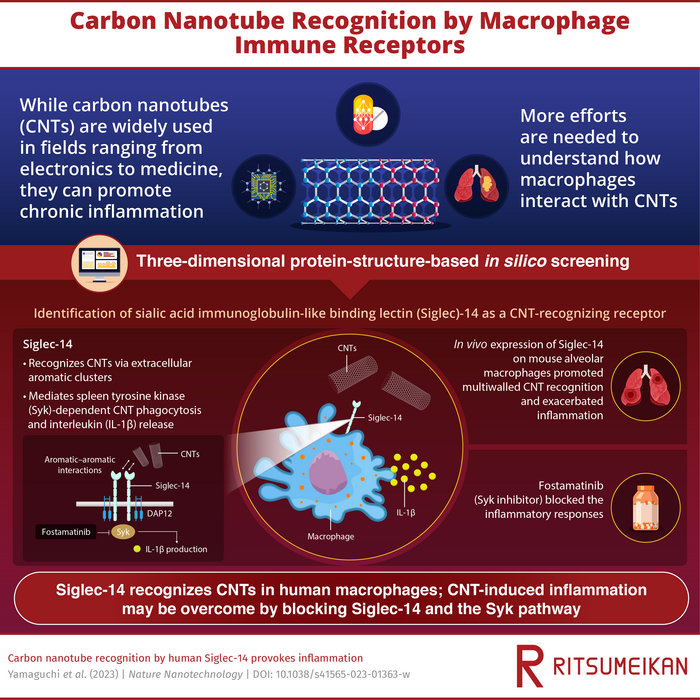Carbon nanotubes (CNTs) have become a mainstay of the field of nanotechnology. Finding innovative applications across materials science, electronics, and medicine, CNTs have garnered a lot of attention from researchers in recent years. However, the International Chemical Secretariat (ChemSec) has moved to flag CNTs on the “Substitute It Now!” database of chemicals likely to be restricted for use. In fact, due to their persistence in nature and potential toxicity to humans, ChemSec has proposed that adequate assessments of CNTs’ risk to human health are urgently needed.

Credit: Masafumi Nakayama from Ritsumeikan University, Japan
Carbon nanotubes (CNTs) have become a mainstay of the field of nanotechnology. Finding innovative applications across materials science, electronics, and medicine, CNTs have garnered a lot of attention from researchers in recent years. However, the International Chemical Secretariat (ChemSec) has moved to flag CNTs on the “Substitute It Now!” database of chemicals likely to be restricted for use. In fact, due to their persistence in nature and potential toxicity to humans, ChemSec has proposed that adequate assessments of CNTs’ risk to human health are urgently needed.
Following their entry into the body, and much like asbestos, CNTs are targeted by the immune system and preferentially engulfed by macrophages. The ensuing inflammatory response–involving inflammasome and interleukin-1β (IL-1β) secretion–can progress to chronic inflammation, fibrosis, and even mesothelioma, as seen in rodent models. Unfortunately, how human macrophages recognize CNTs has remained a mystery.
Now, a team of researchers in Japan have found that extracellular receptors, namely, sialic acid immunoglobulin-like binding lectin (Siglec)-5 and -14, are involved in CNT recognition by human macrophages. The team, which included Professor Masafumi Nakayama from Ritsumeikan University, built upon their previous work that confirmed how mouse T-cell mucin immunoglobulin 4 (Tim4) receptors bound to CNTs via an aromatic-aromatic interface. The findings from this study have been published in Nature Nanotechnology. “We hypothesized that aromatic clusters were essential to CNT recognition. But at the time, it wasn’t evident that Tim4 receptors had a role in CNT engulfment by human macrophages,” says Prof. Nakayama of his motivation for the study.
The group used three-dimensional protein-structure-based in silico screening and ectopic in vivo expression of Siglec-14 receptors to validate how the aromatic rings facilitated the Siglec-CNT interaction. Via molecular dynamics simulations, the team discovered the interaction of aromatic residues on the extracellular loop of Siglec-5 and CNTs. On the other hand, they found that Siglec-14 initiated the spleen tyrosine kinase (Syk) pathway-dependent phagocytosis of CNTs and the release of IL-1β by macrophages. The detection of CNTs was enhanced in mouse macrophages expressing human Siglec-14, and importantly, the team noticed that this interaction greatly exacerbated pulmonary inflammation.
Lastly, the drug fostamatinib, which is a Syk inhibitor, was seen to block the Siglec-14-mediated proinflammatory signal cascade. “This is an encouraging result as this drug may overcome CNT-induced inflammation,” says Prof. Nakayama as he elaborates on the significance of the teams’ work.
While the team is excited about their breakthrough, they are cautious to note that these findings do not mean CNTs have asbestos-like toxicity. Estimating the toxicity of CNTs would depend on a host of other variables: the route of exposure, the CNT dose received, and the size and shapes of the CNTs involved. At this stage, more detailed studies are required to accurately gauge the risk posed to humans.
However, Prof. Nakayama takes pride in knowing that his team have laid the groundwork to help develop safer CNTs. He concludes, “Even if CNTs are likely to cause inflammatory diseases, our findings will help develop novel therapies, like anti-Siglec-14 monoclonal antibodies and fostamatinib, to prevent such conditions.”
***
Reference
DOI: https://doi.org/10.1038/s41565-023-01363-w
About Ritsumeikan University, Japan
Ritsumeikan University is one of the most prestigious private universities in Japan. Its main campus is in Kyoto, where inspiring settings await researchers. With an unwavering objective to generate social symbiotic values and emergent talents, it aims to emerge as a next-generation research university. It will enhance researcher potential by providing support best suited to the needs of young and leading researchers, according to their career stage. Ritsumeikan University also endeavors to build a global research network as a “knowledge node” and disseminate achievements internationally, thereby contributing to the resolution of social/humanistic issues through interdisciplinary research and social implementation.
Website: http://en.ritsumei.ac.jp/
About Professor Masafumi Nakayama from Ritsumeikan University, Japan
Masafumi Nakayama graduated from Tohoku University and then earned his Doctor of Medicine degree from the Graduate School of Medicine at Juntendo University. He is currently a professor in the Faculty of Pharmaceutical Sciences at Ritsumeikan University. His deep interest in the relationship between the immune system and disease drew him to a career in research, and he currently specializes in the analysis of biological defense mechanisms against pathogens. He has published 44 research articles and five books.
Funding information
This work was supported by the Japan Science and Technology Agency (JST), PRESTO under grant number JPMJPR17H9 awarded to Masafumi Nakayama, JST CREST under grant number JPMJCR19H4 awarded to Shinya Toyokuni, the Japan Society for the Promotion of Sciences (JSPS) under grant numbers JP19H03880 and JP22H03340 awarded to Masafumi Nakayama, JP20K12069 and JP21K06052 awarded to Kota Kasahara, and the Uehara Memorial Foundation awarded to Masafumi Nakayama. This research was partially supported by the Platform Project for Supporting Drug Discovery and Life Science Research (Basis for Supporting Innovative Drug Discovery and Life Science Research (BINDS)) from AMED under grant number JP19am0101067 (support number 0314).
Journal
Nature Nanotechnology
DOI
10.1038/s41565-023-01363-w
Method of Research
Experimental study
Subject of Research
Cells
Article Title
Carbon nanotube recognition by human Siglec-14 provokes inflammation
Article Publication Date
6-Apr-2023
COI Statement
The authors declare no competing interest.




